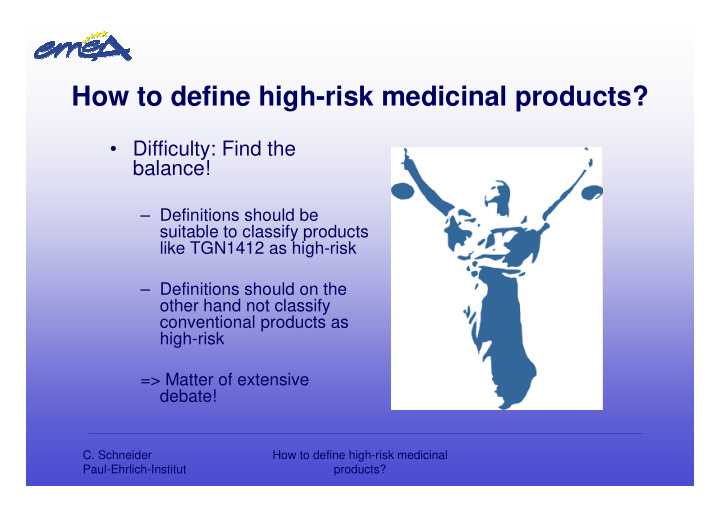



How to define high-risk medicinal products? • Difficulty: Find the balance! – Definitions should be suitable to classify products like TGN1412 as high-risk – Definitions should on the other hand not classify conventional products as high-risk => Matter of extensive debate! C. Schneider How to define high-risk medicinal Paul-Ehrlich-Institut products?
How to define „high risk“? • „Medicinal products are potential high-risk medicinal products when there are concerns that serious adverse reactions in first-in-man trials may occur.“ • Operational definition: Concerns may arise from knowledge or also lack of knowledge regarding … 1. … the mode of action 2. … the nature of the target 3. … the relevance of the animal model(s) • Regulatory consequence: Classification according to the definition criteria to be put to the IMPD / protocol by the Sponsor. C. Schneider How to define high-risk medicinal Paul-Ehrlich-Institut products?
How to define „high risk“? • Important: Guideline repeatedly states that not every novel medicinal product is high- risk, and clearly states that for many new medicinal products the conventional non-clinical programme provides an acceptable safety estimate. C. Schneider How to define high-risk medicinal Paul-Ehrlich-Institut products?
How to define „high risk“? (1) MODE OF ACTION • Novelty, plausibility, extent of knowledge (again: either particular knowledge that there is a higher risk, or particular lack of knowledge) (e.g., newly discovered signalling pathways) • Nature and intensity of the effect (extent, amplification, duration (!), reversibility (!)) • Type of dose response (linear, non-linear, U-shaped, bell-shaped) C. Schneider How to define high-risk medicinal Paul-Ehrlich-Institut products?
How to define „high risk“? TGN1412 • (Mode of action, continued) B7 => More special reference to the following Lühder et al. J Exp Med 2003 aspects: Evans et al. Nature Immunol 2005 – Pleiotropic mechanism, including the immune system – Bypass of physiological control, e.g. (super-) agonists – Novelty of structure, e.g. engineered mAbs or fusion proteins Van Spriel et al, Immunol Today 2000 Jefferis, Nat Biotechnol 2006 C. Schneider How to define high-risk medicinal Paul-Ehrlich-Institut products?
How to define „high risk“? (2) NATURE OF THE TARGET, irrespective of the mode of action • Nature of the target itself might pose a higher risk, even if there is extensive knowledge on the mechanism of action (example: Mechanism is an enhanced cytotoxic effect in tumour cells expressing the target. However, target is expressed in physiological tissues.) • Extent of knowledge on structure, tissue distribution, cell specificity,… C. Schneider How to define high-risk medicinal Paul-Ehrlich-Institut products?
How to define „high risk“? (3) RELEVANCE OF ANIMAL MODEL • Central: How reliable is the target species for non-clinical toxicology testing? • Comparison should include functional data (binding alone not sufficient, see talk Prof. Silva-Lima). • Limited relevance might lead to „high risk“ classification. C. Schneider How to define high-risk medicinal Paul-Ehrlich-Institut products?
Comments on section 4.1 of the guideline • Repeatedly stated that section is too broad – virtually every new compound would be considered a potential high-risk compound – Fear of non-harmonized interpretation by NCAs • Various proposals to narrow to more specific classes , e.g. – Monoclonal antibodies or even only full-length mAbs – Agonistic compounds (as suggested by Duff Report, which appears more specific) • Request for specific examples • Define „non-high risk“ in addition • Request to re-define the focus on „serious adverse reactions“ as basis for the „general“ definition • Proposal to change the scope from a definition to criteria for risk mitigation strategy including the request to avoid „black and white“ („high-risk“ vs. „non-high-risk“) C. Schneider How to define high-risk medicinal Paul-Ehrlich-Institut products?
Recommend
More recommend